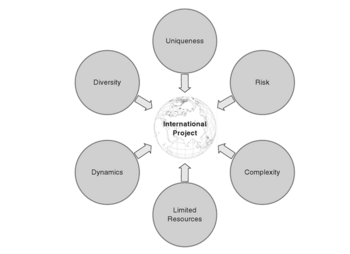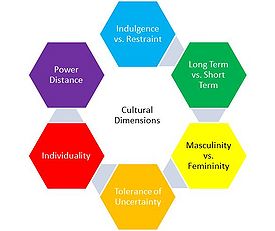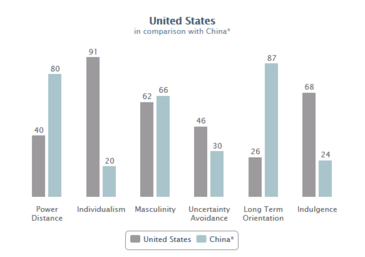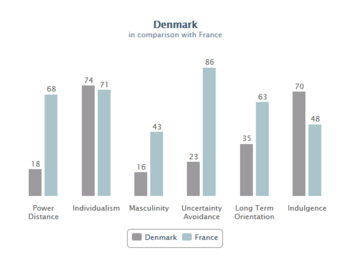International Project Management
Globalization has brought us a more integrated and interdependent world economy and therefore is creating an increasing number of international project, i.e. a project that reach beyond national boundaries regarding either the project purpose or the nationality of the stakeholders. However, survey shows only a 40% success rate of international effort. One would think that standard project management methods can be applied within those project as it is quite successful on a national scale. But international projects bring many different issues that are not covered by standard methods. One of the most difficult challenge companies have to undergo is cultural differences. To identify and mitigate all the new issues created by international projects, international project management requires unique methods, tools and techniques.
This article will first deal with the definition of international project management and emphasizes the main differences between international projects and standard projects. A method to identify all the challenges that ensues from international projects will be developed as, depending of the project, you can have quite different issues. Finally, the key success factors in international project management will be exposed.
Contents |
What is an international project ?
General idea
In international project, you have the word project, so of course you can consider it as a directed work that is aimed at achieving specific goals within a defined budget and schedule. However, what’s make International Project different is that it involves multiple locations, entities organizations, and business units.
These are a few examples of what you can consider as international project management :
- A major construction project in another country that involves many subcontractors of different nationalities e.g. Femern Tunnel in Denmark
- Two companies are merging their operations e.g. AB In Bev and SABMiller
- A company is deploying a new product in a region e.g. l'Oréal Marketing Plan
- International efforts by governments e.g. war against terror or migration policy
- A major construction project in another country that involves many subcontractors of different nationalities e.g. Femern Tunnel in Denmark
Main characteristics
- Complexity
Those projects have all in common a major characteristic : they are complex project. In this case, complexity is more due to organizational and geographical causes. The manager is faced to multiple interdependencies and stakeholders spread around the world. He has to find an adequate structure to cope with interdependent interactions but also which enable communication across different time zones. In fact, the complexity of those project is one of the reason why standard management techniques did not work well.
- Risk
Because of this complexity, another characteristic is risk. In most of those project and especially in the construction field, budget and planning over-runs are expected. It is common in standard project too but the factor for uncertainty is much higher in International Project like a political instability in one of the country involve or a change of government and a new political line.
- Uniqueness
International projects have unique objectives and most of the time no former example to look for. The context in which they happened is quite different : countries have different cultures, societal and political structures, technological levels or different attitudes regarding sustainability for example.
- Diversity
Another characteristic of those projects is diversity and cultural differences is one of the biggest challenge managers will have to face. Organizational structures may differ among the different nationalities represented as well as the languages spoken. Also educational and social background may have a huge impact of the way of working of the different stakeholders and managers have to take into account this diversity.
- Dynamics
They may also face numerous and sudden changes within the project. To take into account the risks or new opportunities that may encounter the project, managers have to take the right decisions quickly. An example in a construction project may be the bankruptcy of a sub-contractors or a new regulation on construction site.
- Limited resources
Moreover, the larger scope of the project implies also more resources needed especially regarding time for planning, money for transportation and co-ordination efforts. Another limited resource is the staff : it is really difficult to find the staff with the right skills to manage language and intercultural diversity.
All those characteristics make why international projects are different than standard project. Standard management techniques cannot achieve to solve the difficulties involved in international project especially regarding the scope, the purpose, the main stakeholders and the risk intensity. So that’s why new techniques and tools have to be developed.
Identify the challenges
Cultural awareness in one of the keys to achieve successfully an international project. The Hofstede 6-D model in one of the tools that can be used to identify the different cultural challenges that a company or a manager can encounter during the project.
Hofstede 6-D Model
In his model, Hofstede identified 6 keys areas of cultural differences, hence the 6-D, and so allow you to make a comparison between two or more countries. Thanks to this tools, you can quickly notice which are the main cultural differences, you can be confront with during the project. To do this, Hofstede decided to score each of the 6 categories on a scale of 0 to 120.
- Large vs Small Power Distance
Regarding of their cultural background, people have a different acceptance of unequal distribution of power. This differences could have a huge impact on the relationship between two companies and the way meeting are conducted. People in Large Power Distance societies respect a strong hierarchical order often linked to seniority. In the contrary, People in Small Power Distance society will ask for justification of power inequalities and preferred power equal organization.
- Strong vs Weak Uncertainty Avoidance
This is the degree to which members of a society feel uncomfortable about flexibility and sudden changes. It is linked to the acceptance of uncertainty and the way people of a different social background reacts to ambiguity and the time it takes to them to react on it.Uncertainty avoidance is, in fact why people tends to believe in institution which aim to create rules and protect conformity. Strong Uncertainty Avoidance Society does not tolerate deviant or too unconventional attitudes and will not reward innovative people, whereas Weak Uncertainty Avoidance society will just let the future happens and work in a more relaxed atmosphere. In this kind of society practice is more important than rules or theory, it is what make people acts well and fast when a sudden change appears. Time, by definition bring uncertainty and this criterion help to understand the reaction of society regarding that fact, will they try to control it and let a small room for risk or will they just let it run its way without any barriers. Of course, it has a huge impact on the way people build their organizations and instances like Power Distance.
- Individualism vs Collectivism
This mostly concerns the way people think about themselves : is it as a “I” or a “we” ? Individualist think first about themselves and their immediate family. Their own achievement in the company is one of the most important thing during their carrier. They are inclined to work against the needs of the group if it means a bigger reward. Collectivism, its opposite, prefers a very tight social network, people will do anything for the team without looking after their personal involvement, but ask in exchange, for unquestioning loyalty. In a society with a high individualism culture, it might be the best solution to engage directly with the key person and allows him to recognize some part of the work as his own success.
- Masculinity vs Femininity
People in a masculine society tends to value achievement, heroism, assertiveness, and material success, whereas in feminine societies, caring for others and quality of life are more important. Moreover, a high masculinity rate means that males dominate a significant portions of the society, they are the leader. The closer you get from the source of power, the higher chance you get to find only male representatives. This will provide societies based on performance. On the contrary, feminine societies strive for minimum social differentiation between the sexes. Men are willing to take modest, caring roles. Those societies even if still showing a high rate of men in their institution, have a mentality more oriented towards care and quality of life. They are called “welfare societies”. This criterion mostly concerns the self-perception of people and the role they think they have to play in the society.
- Long vs Short Term Orientation
This is the one of the latest dimension added to Hofstede Model. It measures the preferences of the long term horizon over the short term. It can explain to which extent a society shows a belief in absolute truth and conventional or short term point of view instead of having a pragmatic vision oriented toward future perspectives. Long term orientation society will show more perseverance in achieving a task and won’t stick to deadlines and milestones. In the contrary, people from Short term society will look more for personal steadiness and stability and therefore try to fulfil all their obligation on time. They need a very tight framework and a well-planned project.
- Indulgence vs Restraint
We can also add another cultural dimension : Indulgence Vs Restraint. This is basically a measure of the happiness in a society, it is related to the way people enjoy life and have fun. In a restrained society, gratification will be held back by strict social norms and people are not in control of their emotion and life because the society dictates how they have to behave. In a more indulgent society, people feel free to receive gratification and to express themselves. Social pressure is less important : people can act as they want and therefore really enjoy their life.
Some worldwide results
Thanks to this two diagram, we can make some useful remarks. For example, both China and France have a high power Distance whereas Denmark have one of the lowest. This means than in France and China there is a strong sense of leadership and respect toward the powerful people but in Denmark, equality is prevalent. But it is the strong individualism of the French that is strange because it does not quite get along with strong Power Distance. This means that even if the French seems to respect hierarchical order and leadership, they think first about their own life and commitment. In the contrary, American low power distance combine with a high individualism is quite characteristic of their country as they worship liberty. This can explain why there is so many strikes. Moreover, regarding masculinity, both Denmark and France have a low score which can be explain by french “welfare state” and Danish culture where men have more responsibility at home and quality of live take a huge place. Regarding Uncertainty Avoidance, both Chinese and Danish have a low rate, so they comfortable with ambiguity and sudden changes, whereas French need norm and rule as well as a well-planned structure and activity. Finally, we can say that both American and Danish try to enjoy their life as much as they can and have their own life under control. This is not surprising when we know that Denmark is the happiest country in the world.
Implementation of international project management
Launch the project
Define the project
As the scope of the project is quite wide and the purpose of such international project are numerous, a good definition of the case is crucial and an approach has to be described.
- Measure the current situation
To do this, you have to understand the process better so you can define the project with greater clarity. You will also help people to understand all the problems and limitations with the current situation. Finally, you can validate or not the fact that the project is needed. - The project concept
Thanks to the background knowledges of the current situation, you can establish the project concept. It means developing the purpose of the project from several point of view, the scope of the project, the roles and responsibilities of stakeholders, availability of resources, the initial issues it will have to faced, the budget and the schedule and the potential benefits. This should give a solid base to your plan. - Define objectives
Then, you have to define the purposes of the project. There is 3 kind of purposes : technical, business and political. The technical purpose relates to the physical activity like IT, construction or distribution. The business purpose is the true purpose of the budget whereas the technical purpose, you think only about how you can achieve it. The initiators of most of the international project is government so politics is at the core of the project. - Determine the scope of the project
You can either look to the dimensions of the project overall each country or look for the impact factors. In the first point of view, you consider thing as number of location, departments involved, extent of system and technology, risk or elapsed time for the project. For the other mind, impact factors may include cost, benefits, risk and elapsed time for the project. - Establishing roles, responsibilities and resource availability
Once you determine one or two scopes of the project, it can be useful to define the roles and responsibilities of each stakeholder. During this place, people start to become more excited as they can see the impact of the project on them. Then you may need to also establish the resources needed and all the issues that may impact resource availability. - Estimate costs, benefits and the schedule
This estimation will not be precise but it is a base so that you can work on it afterwards. During this part, you can use experience from tour past project to get the better estimation possible at this time of the project. - Identify the potential issues for the project
Issue can be generating in different fields such as organization, management, system and technology, customers, suppliers and vendors, project work, project staffing and leadership, external factors such as laws, regulation and competition. To identify those issues allows you to discuss how to resolve them during the planning phases and therefore not to wait until they happen. - Determine project interdependencies
An international project tends to be interdependent in many potential ways so you have to identify all those links and how they depend on each other. This is an important tasks if you want to correctly interact with everyone during the project. - Present the project
After collecting all those information, you will have to present the project concept to the stakeholders and reach for their approval. A good idea is to identify two or three possible concept and highlight their advantages and drawbacks so the project leaders manage to get a full overview of the situation.



